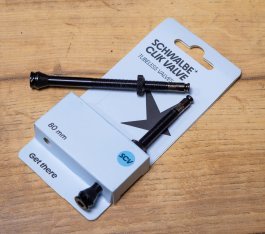
The ultimate guide to winter commuting
Cycling through autumn and winter: motivation, gear and safety tips. We’ll show you how to get yourself and your bike ready for the cold season.
Functional, durable, and easy to use – the Schwalbe Clik Valve promises to be the best bicycle valve yet. We decided to give it a try!
In 2024, Schwalbe introduced an entirely new valve standard for bikes: the Clik Valve! It's named after the characteristic “click” sound and feel you get when pressing the matching pump head or adapter onto the valve. It’s so easy to use that, quite literally, even kids can do it. The new valves are designed to be not only easier to handle but also more robust than the widely used Presta valves, and with their higher airflow, they’re better suited for tubeless setups. We took a closer look at the new Schwalbe Clik Valve (abbreviated SCV) and the corresponding pump adapters, and put them to the test for you.
If you want an overview of all common types of bicycle valves and their advantages, you can find it here: Bicycle Valves Compared: Presta, Schrader & Clik Valve
The diameter of a Clik Valve is roughly the same as that of a Presta valve, but technically the SCV functions more like a Schrader valve: in the center sits a small pin that is pressed in by the pump head, opening the valve for airflow. A spring keeps the valve closed when no air pump is attached. The real highlight, however, is the click connection that gives the system its name: a Clik Valve pump head or adapter simply slides onto the valve and locks into place. You don’t need to unscrew anything on the valve or flip a lever on the pump head. Attaching it takes hardly more effort than plugging in a smartphone charger. Once the tyre is inflated, just pull the head off again: click and you’re done! The valve closes so quickly that it works almost without air loss. The only hiss you might hear comes from the air inside the pump hose.
Another innovation: Clik Valve pump heads work without rubber seals, making them far less prone to wear—or none at all. They are also more compact than most conventional pump heads. This is a big advantage for small wheels where there is little space above the valve – for example, on kids bikes.
The Schwalbe Clik Valve (SCV) is a fairly new invention designed to outperform traditional bicycle valves like SV, AV, or DV. Let’s take a closer look to see if it delivers on that promise. © bc GmbH

Clik Valve is the valve standard for everyone who doesn’t want to think about bike valves. © bc GmbH

Instead of converting your existing tubeless valves to Clik Valve, you can simply buy the Schwalbe Clik Valve Tubeless version directly. © bc GmbH
You can quickly and easily convert most Tubeless valves or inner tubes to Clik Valve. There are versions for Dunlop and Presta valve stems (DV and SV) as well as for Schrader valves (AV). For SV, it is important that the existing valve cores are removable (some tubes don’t allow this) and that the valve stems are made of metal. Plastic stems, such as those found on some ultra-light thermoplastic tubes, are not suitable for conversion to Clik Valve.
Valve core out, valve core in: Tubeless valves can also be easily and quickly converted from Presta to Clik Valve. © bc GmbH
The corresponding Clik Valve insert simply replaces the Dunlop valve and is secured with the existing locknut. © bc GmbH
If you have a pump with a Clik Valve pump head, inflating your tyre couldn’t be easier: remove the valve cap (it clicks off just as easily), click the pump head onto the valve, and start pumping. The pressure gauge on the pump continuously measures the air pressure. Once you have enough air in the tyre, simply pull off the pump head, click the valve cap back on, and you’re done.
Attaching the pump has never been easier: the Clik Valve pump head simply clicks onto the valve and locks into place. © bc GmbH
Click! The valve caps are also simply pressed onto the valve from above. © bc GmbH
The good news: Clik Valve was designed with a certain degree of backward compatibility. If you have a pump head for SV that clamps onto the valve with a lever, it will most likely also work with SCV. However, the pressure gauge on your pump might show inaccurate readings because it measures the pressure in the hose. In that case, the pressure before pumping is zero and after pumping higher than in the tyre.
SV pump heads that screw onto the valve unfortunately do not work directly with SCV.
For AV pump heads (screw-on or clamp type), there’s a practical adapter included with SCV conversion kits. Screw or insert the adapter into the pump head and secure it with the lever. You can now use your pump just like a Clik Valve pump—simply push it onto the valve. The pressure gauge works as usual. Note: If you place the adapter onto the valve before connecting the pump, it will open the valve and air will escape quickly.
A potential mistake and life hack in one: A Clik Valve pump adapter without a connected pump releases all the air from the tyre in seconds. © bc GmbH
To release air from a Clik Valve, you can press or gently tap the small pin in the middle of the valve—perfect if you just want to fine-tune the pressure. Most people can do this with a fingernail, but Schwalbe recommends using the edge of the valve cap. Alternatively, a small hex key or a similar tool works just as well. Tip: If you want to release all the air (for example, when changing a tyre), simply attach the SCV adapter from the conversion kit to the valve. It opens the valve, and without a connected pump, all the air escapes completely. After the “click,” comes the “pssshh.”
The easiest way to let the air out is by using the edge of your fingernail. © bc GmbH
To measure tyre pressure with a Clik Valve, you can use either a pump with an SCV pump head or the adapter, as described above. If you only want to measure, keep in mind that when attaching the pump head, the hose fills with air from your tyre. If you don’t pump afterward, you’ll lose a small amount of air — but only when attaching, not when removing the pump head.
Analog and digital hand pressure gauges for SV and AV are generally not compatible, but the SKS Airchecker 2.0 is already designed for SCV. Valve systems with built-in wireless pressure sensors, such as Quarq Tyrewiz, SKS Airspy, or the Schwalbe Airmax Smart Bike Sensor, can be converted to SCV just like regular SV valves and will continue to measure as usual.
Attaching the pump has never been easier: the Clik Valve pump head simply clicks onto the valve and locks into place. © bc GmbH
The new version of the SKS Airchecker is compatible with the Schwalbe Clik Valve and features a convenient air-release button. © bc GmbH
Does the Clik Valve live up to its promises? Yes! We easily converted tubeless valves from SV to SCV, and it worked exactly as described. The valves look great and feel solid. Attaching the SCV pump head – or a regular one using the adapter from the conversion kit – is so effortless that you wonder why we ever bothered with levers and screw fittings. In our test, the airflow was strong enough to seat a tubeless gravel tyre on the rim using a standard floor pump. We only deduct half a point when it comes to releasing air precisely to fine-tune pressure. It works, but not quite as smoothly as with SV. Otherwise, the Schwalbe Clik Valves are as simple and discreet as you could wish for. Click, pump, click, and ride.
If user-friendliness matters to you, you should definitely give Clik Valve a try!
The Schwalbe Clik Valve is a new bike valve designed to make inflation easier and more user-friendly.
Yes, the Clik Valve has been available since winter 2025. Availability may vary due to high demand. Tip: In our shop, you can filter by availability.
A simple mechanism in the Clik Valve pump head locks into the groove on the valve when you push it on. A thin tube inside simultaneously presses down a pin in the valve to open it. The seal between the pump head and the SCV is made inside the valve. When you remove the head, it closes automatically.
Yes, since there are Clik Valve conversion kits for all common valve types, they are also compatible with older rims.
You can easily order the Clik Valve online from bike-components since its market launch in winter 2025. Prices vary depending on the version and conversion kit.